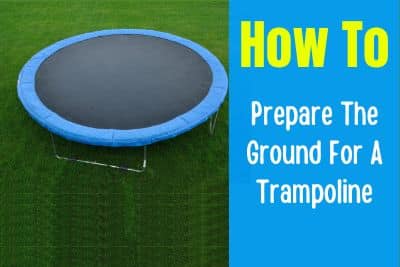Maybe you’re planning to get a trampoline soon, so you’re a little confused about where to place the trampoline in the yard, right? The best place to set up a trampoline is a leveled lawn with adequate space around the trampoline.
If the backyard isn’t ready, you have to prepare the ground properly to install the trampoline. So, how to prepare the ground for a trampoline? Several steps to make the garden ready for your trampoline are choosing a good place, measure the spot, harden the ground, level the uneven place, adding soft base materials, and many more.
Let’s have a discussion on the right place to install a trampoline with trampoline ground preparation tips.
How to Prepare the Ground for a Trampoline?
Getting the ground ready to set up the trampoline, you have to do several tasks. These are discussed below-
Step 1: Select a Good Spot for Trampoline
So, where to place the trampoline in the garden? While selecting a place to install a trampoline, consider the following things-
Best Place to Put a Trampoline

- The ground should be flat with plenty of lawn, but if there is excessive grass, trim it well
- Select a solid surface that can hold the trampoline
- Adequate clearance surrounding the trampoline
- No hanging tree branches over the trampoline
- Be sure the trampoline has adequate headroom
- The place should have proper lighting
- Make sure the yard has proper drainage
- If there are wind barriers, that are a bonus for wind protection
You Should Avoid These Places to Set up a Trampoline
- Concrete or rocky surfaces
- Slope or uneven ground
- Next to a building or tree
- Too much moist surface
- Over the septic field
See Also: Where are the right places to buy trampolines?
Step 2: Measure the Area
After finding an ideal place, your next task is to measure the area to be sure the trampoline will fit there well. But consider clearance space with your trampoline dimensions.
Depending upon the trampoline type, you should measure and mark the space. The available space in your yard will tell which size and shape of the trampoline will suit your garden best.
See Also: Tips to measure any trampoline easily
Step 3: Ensure Proper Clearance
Now cut the excess grasses, scrubs, and bushes from the place where you are going to install the trampoline. Also, clear debris from the site. If there is any stone, sharp items, or hard objects, remove them for safety purpose or move the trampoline to a good place.
Cut the hanging tree branches and clear the space on each side of the trampoline too. After clearing the spot, make sure there are at least 3 ft of space around the trampoline.
The clearance will help in trampoline moving, clearing, getting on and off the trampoline, and many more. This extra space also protects jumpers from getting injured if they fall to the ground accidentally. But, you can extend the trampoline’s safety by adding an enclosure net.
Step 4: Harden the Surface
Trampolines should be set up on solid d ground that can withstand the trampoline’s weight well. In this way, the trampoline will help you create good bounces on trampolines.
If you install the trampoline in a moist or swampy place, it will sink onto the earth due to the excessive load of the trampoline and extra pressure while jumpers bounce there. In this case, you need to put some extra items like gravel, sand, dirt, hay, etc, to harden the ground.
But, don’t put the trampoline on concrete or cement directly. If you want to do that, add some cushioning materials such as a floor mat, foam pad, etc, to avoid the impact of the hard surfaces.
Step 5: Level the Uneven or Slope Ground
If the ground of your trampoline is the slope or uneven, it’s essential to make it to level before installing the trampoline. For that, you can add soil to the dips, use leveling blocks, dig trenches, and many more.
Here is an ideal leveling block by Tri-Lynx to level the trampoline.

Step 6: Construct the Drainage
Besides leveling the ground, your backyard needs enough drainage to drain out rainwater. Otherwise, water will clog there and could damage the trampoline.
So, build a drainage system and connect it with the central drainage. This not only keeps the ground dry, but also protects the garden snakes and predators.
Step 7: Put Soft Thing under the Trampoline
Before installing the trampoline in the garden, it’s important to put a good base material under the trampoline for a safe trampoline base. Some of them are wood mulch, rubber mulch, grass mat, play sand, gymnastic mat, etc.
These materials will make the trampoline ground soft and comfortable. So, if someone falls to the ground while jumping on the trampoline, he won’t be hurt too much.
See Also: Can you install a trampoline in a desert?

Step 8: Aesthetics
This is an optional stage to prepare the ground for the trampoline. If you love aesthetics and beauty, you may decorate the trampoline and garden together.
You can plant trees, shrubs, and flowers at the borders of the garden. Alleyway also adds great aesthetics to the whole yard and the trampoline.
Step 9: Install the Trampoline
When your yard fulfills all the above-mentioned steps, consider it as ready to put your trampoline there. So, recheck all the steps again and if everything is okay, then go for the installation of the trampoline there.
See Also: Trampoline installation mistakes
Preparing the Ground for an In-Ground Trampoline
If you want to install an in-ground (sunken) trampoline, the process of ground preparation will be a little different than the usual trampoline. The setup style of in-ground trampolines varies from the above-ground trampolines, so their ground preparation will also differ.
In-ground trampolines need a hole to sink the whole trampoline there. Also, it needs drainage preparation and retaining wall building.
After finding a good site, determine whether the place is a high-water table or not. Now, dig an approximately 3 ft deep trial hole and let it for a day.
If the trial hole fills up after 24 hours, the place needs a retaining wall, otherwise, you can put the trampoline there. It’s recommended to make an in-ground trampoline hole in the dry season.
While sinking the trampoline, keep it a few inches above the ground. This will let air passes easily. Thus, you will get a comfortable bounce from the trampoline.
Also, build a drainage system from the bottom of the pit and connect it with the central drainage. This will prevent clogging water under the trampoline.
See Also: Is it okay to put a normal trampoline on the earth?
People Also Ask
1. How much does it cost to prepare the yard for the trampoline?
Ans: This depends on which type of ground preparation you are doing. If the yard is flat, then you can prepare the ground at $100 or less. However, it needs around $200 or more for a slope or uneven ground.
See Also: Get an idea of the trampoline’s price
2. How much overhead space is required for the trampoline?
Ans: Many trampoline manufacturers recommend at least 8 m clearance above the trampoline. Don’t ignore this clearance when you are jumping on a bouncing trampoline.
3. How much clearance is needed around the trampoline?
Ans: Most renowned trampoline manufacturers suggest keeping a minimum of 1.5 m clearance around the outdoor trampolines.
Conclusion
Ground preparing for the trampoline isn’t very difficult. The main thing is to make the yard leveled. However, if your garden is already flat and firm the ground is almost ready to install the trampoline.
But, if the ground is not even, it needs extra effort to make it even. After leveling the ground, be sure there are plenty of spaces around the trampoline, so jumpers won’t get knocked by the surrounding items.
Also, put an extra comfortable layer under the trampoline like wood mulch, rubber mulch, artificial grass, play sand, and others. In addition to that, you can add aesthetics to the yard.
By now, you know the ins and outs of how to prepare the ground for a trampoline and the best place to install the trampoline in the backyard. Hopefully, you can prepare the yard successfully for the trampoline.

Robert is a trampoline and rebounder trainer with a passion for blogging. He discovered his love for trampolining at a young age, when his father gifted him his first trampoline at the age of 9. Over the years, Robert has honed his skills and knowledge in the field, and now uses his expertise to train others.
Besides, helping fitness enthusiasts in the gym, Robert is very eager to share his knowledge and experience regarding trampolines and rebounder exercises with the readers of picktrampoline.com. He will share all you need to know about trampolines and rebounders in this blog. Get his tips on trampoline and rebounder!

